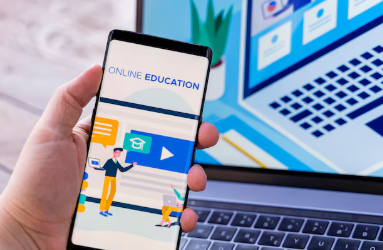The ferocity of the internet revolution, particularly in the field of learning, is becoming more pervasive every day. With the eLearning sector projected to reach a record $1 trillion by 2032, it's safe to say that the future of learning is online.
In terms of the future, are you aware of what's coming up next? In the past, we've seen many innovative inventions that have pushed the market for e-learning to new levels. But is this the case? Absolutely not!
As we enter the dawn of a new age with revolutionary technological advancements, the world of learning through digital technology will be expanded further, becoming more efficient, synergistic, and inclusive.
If you're an online teacher or institution looking to get a head start on this, read this blog. This blog will examine the top seven most anticipated trends in interactive eLearning and the best practices for 2024 and beyond. Let's get started!
Importance Of Staying Updated With Latest eLearning Trends In 2024
As eLearning continues to develop, educators, students, and professionals need to keep up with the most recent trends on the subject. Staying on top of these developments will enhance your learning experience and boost the quality of instruction while ensuring that education is relevant in today's digital world.
By analyzing and incorporating emerging eLearning trends of 2024, teachers can design more efficient and engaging online courses. Students will benefit from individualized learning experiences. Additionally, professionals working in the eLearning sector can stay ahead of the market by taking the edge of these trends to create creative Learning App Development Solutions.
Artificial Intelligence (AI) In eLearning
One significant change shaping the future of online learning is the blending of artificial intelligence (AI) technologies. AI technologies are poised to transform education by providing tailored learning experiences and intelligent feedback.
AI-powered eLearning platforms can analyze the learner's information and behavior to customize the learning experience to meet individual requirements. This can be adjusting the difficulty level of material, recommending specific content, and providing immediate feedback. With AI, students can get specific guidance and support, which can improve learning outcomes.
In addition, AI can automate administrative tasks like managing course management and grading, allowing teachers to focus on deeper conversations with students. This trend of online education is likely to grow and make eLearning easier and more efficient.
Gamification And Interactive Learning Experiences
Gamification is another area that is changing the face of learning through e-learning. Educators can boost engagement and motivate students by integrating game components such as leaderboards, badges, and rewards into the learning process.
Interactive learning experiences not only make learning more enjoyable but also foster active involvement and the ability to think critically. Gamified eLearning platforms allow learners to establish goals, monitor their progress, and even compete against others, creating satisfaction.
Additionally, gamification can create realistic situations, allowing students to use their real-life knowledge and skills. This type of trend in eLearning is especially beneficial for training based on skills in which learners can test and develop their skills using immersive simulations and virtual environments.
Personalized Learning Through Adaptive Technology
The future of eLearning is focused on personalizing learning experiences, which is why adaptive technologies play a crucial part in making this happen. Learning systems adapt to changing conditions using data analysis and Machine Learning algorithms to personalize educational content according to each learner's needs.
Adaptive technology can design custom learning pathways by collecting and analyzing data about learner preferences, performance, and progress. This will ensure that students receive learning materials that are relevant to their needs, challenging, and tailored to their individual learning styles.
Adaptive technology allows educators to monitor and track student development in real-time and provides quick interventions and assistance. This individualized method of eLearning increases student satisfaction and engagement and improves learning outcomes.
Mobile Learning And Microlearning
With the increase in mobile phones and smartphones, mobile learning has become an increasingly popular aspect of online education. It allows students to access educational material anytime and from anywhere, making learning more convenient and flexible.
On the other hand, microlearning is the process of delivering small, targeted learning modules. These short bursts can be digested quickly and efficiently and are designed to meet the demands of today's learners for quick attention spans and mobile learning.
Microlearning and mobile learning are inextricably linked because mobile devices are the perfect platform for providing microlearning materials. Students can take part in brief, interactive lessons that are easy to absorb and can improve retention and transfer of knowledge.
Virtual Reality (VR) And Augmented Reality (AR)
AR and VR are the latest technologies changing the landscape of eLearning. VR lets students experience an immersive virtual world resembling real-world scenarios while allowing immersive learning. AR, on the other hand, overlays digital data in real-world settings to enhance learning with interactive elements.
These technologies can transform Educational App Development Services by offering an immersive and interactive learning experience. Students can visit historical sites as they conduct virtual explorations or interact with virtual items to make learning more engaging and memorable.
Additionally, virtual reality (VR) and augmented reality (AR) can aid theoretical learning and practical application, allowing students to use their knowledge in a real-world context. This new trend in eLearning is especially useful for STEM subjects, where students can visualize complicated concepts and experience them hands-on.
What is the Future of E-learning?
E-learning's future has the potential to undergo significant changes driven by technological advances and evolving educational philosophies. Here's an in-depth look:
Personalized learning experiences: The Education App Developmentin Artificial Intelligence (AI) and machine learning algorithms will create highly customized learning pathways for people. These systems analyze learners' behavior, preferences, and performance data to customize education content, pacing, and tests to meet individual requirements.
Microlearning Development: The growing trend of microlearning, which involves providing content in smaller, specific segments, is predicted to continue. This technique allows for smaller attention spans and enables learners to learn specific skills or acquire knowledge in smaller, bite-sized pieces.
Immersive technologies: Virtual Reality (VR) and Augmented Reality (AR) will be more significant in e-learning. Immersive experiences are designed to replicate real-world scenarios and provide learners with hands-on instruction and practical learning.
AI-Driven Assessments: AI-powered assessment tools will become more sophisticated and offer automated grading, adaptive tests, and immediate feedback. This allows for a more accurate assessment of the progress of learners and performance.
Gamification Enhancements: The principles of gamification will continue to improve e-learning experiences. Games, such as badges, leaderboards, and interactive challenges, are included in educational tools to stimulate learners, boost engagement, and create an attitude of competition.
Mobile Learning Dominance: Mobile learning is expected to dominate the world of e-learning in response to the growing need for mobile, convenient education. Apps for mobile and responsive designs will be essential in delivering seamless learning experiences across various devices.
Social and collaborative learning: Interactive platforms and social networks will promote collaboration in learning. Students will participate in group projects, discussions, and peer-to-peer education, encouraging a sense of community within virtual learning environments.
Blockchain Technology for Credentials: The Blockchain can be used to protect and speed up credentialing procedures. This transparent and decentralized system will guarantee the authenticity of diplomas, certificates, and other educational credentials.
The Lifelong Learning culture: A social shift towards continuous learning is expected to become a reality. People will adopt a lifetime learning approach and recognize the importance of constantly developing new skills and knowledge to stay current with the changing professional horizons.
Global Access and Inclusion: Learning through technology will eliminate barriers to access across the globe, providing students with diverse backgrounds access to a high-quality education. Focusing on inclusion will reduce differences in educational opportunities, resulting in a more equitable learning environment.
The future of online learning is defined by the ability to adapt, personalize, and use cutting-edge technologies to deliver stimulating, effective, and accessible learning experiences.
Conclusion
E-learning's future appears promising, thanks to trends like AI gaming, gamification, adaptive technologies, mobility learning, and VR/AR changing the educational sector. These changes make education more personal, engaging, and easier to access, which leads to better learning outcomes and increased engagement.
It is vital for educators, students, and others in the eLearning business to keep up with these E-Learning Solutions and take advantage of the opportunities they provide. By utilizing technology's potential, we can design an environment where education can be flexible, enjoyable, and productive. Therefore, let's embrace this digital future of education and tap learning's fullest potential in the digital age.




